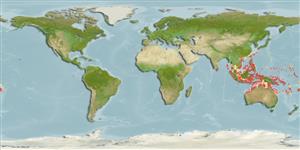Classification / Names
Common names from other countries
Main reference
Size / Weight / Age
Max length : 8.0 cm TL male/unsexed; (Ref. 9710); common length : 6.1 cm SL male/unsexed; (Ref. 37816)
Environment
Marine; reef-associated; depth range 1 - 40 m (Ref. 54391), usually 2 - 15 m (Ref. 90102)
Climate / Range
Tropical, preferred ?; 30°N - 23°S
Distribution
Short description
Dorsal
spines
(total): 7;
Dorsal
soft rays
(total): 9;
Anal
spines: 2;
Anal
soft rays: 14 - 16. Diagnosis: Rays: dorsal VI + I,9; anal II,14-16 (rarely 13 or 17); pectoral rays 13-14 (rarely 12). Gill rakers 5-7 + 14-17 (total, 19-23). Lateral-line scales 25+3-4 (rarely 27 or 30). Median predorsal scales 6-7 (rarely 5). Body depth 2.5-2.8 in SL; body width 2.3-2.65 in body depth; eye diameter 2.7-3.2 in head length; first dorsal spine 1.5-1.9 in second spine; second dorsal spine 2.35-3.0, and third dorsal spine 2.35-3.1 in head length; spine of second dorsal fin 2.2-2.6, and second anal spine 2.5-3.1 in head length; pelvic-fin length 4.5-5.1; caudal-peduncle length 4.5-5.4 in SL. Distance from insertion of pelvic spine to anal-fin origin 4.1-5.5 in SL Preopercular edge serrate. Scaly sheath along anal-fin base moderately developed (Ref. 54391).
Some geographical variations. Usually a black band below second dorsal fin, but highly variable in width and may fade to barely a trace, or is completely absent. In Japanese and Indian Ocean populations, the band is usually narrow and often absent. Best identified by the two vertical orange stripes over gills and distinctive black peduncular spot (Ref. 48635).
IUCN Red List Status (Ref. 115185)
Threat to humans
Harmless
Human uses
More information
ReferencesAquacultureAquaculture profileStrainsGeneticsAllele frequenciesHeritabilityDiseasesProcessingMass conversion
Tools
Special reports
Download XML
Internet sources
Estimates of some properties based on models
Phylogenetic diversity index
PD50 = 0.5001 many relatives (e.g. carps) 0.5 - 2.0 few relatives (e.g. lungfishes)
Trophic Level
3.5 ±0.50 se; Based on food items.
Resilience
High, minimum population doubling time less than 15 months (Preliminary K or Fecundity.)
Vulnerability
Low vulnerability (10 of 100)
Price category
